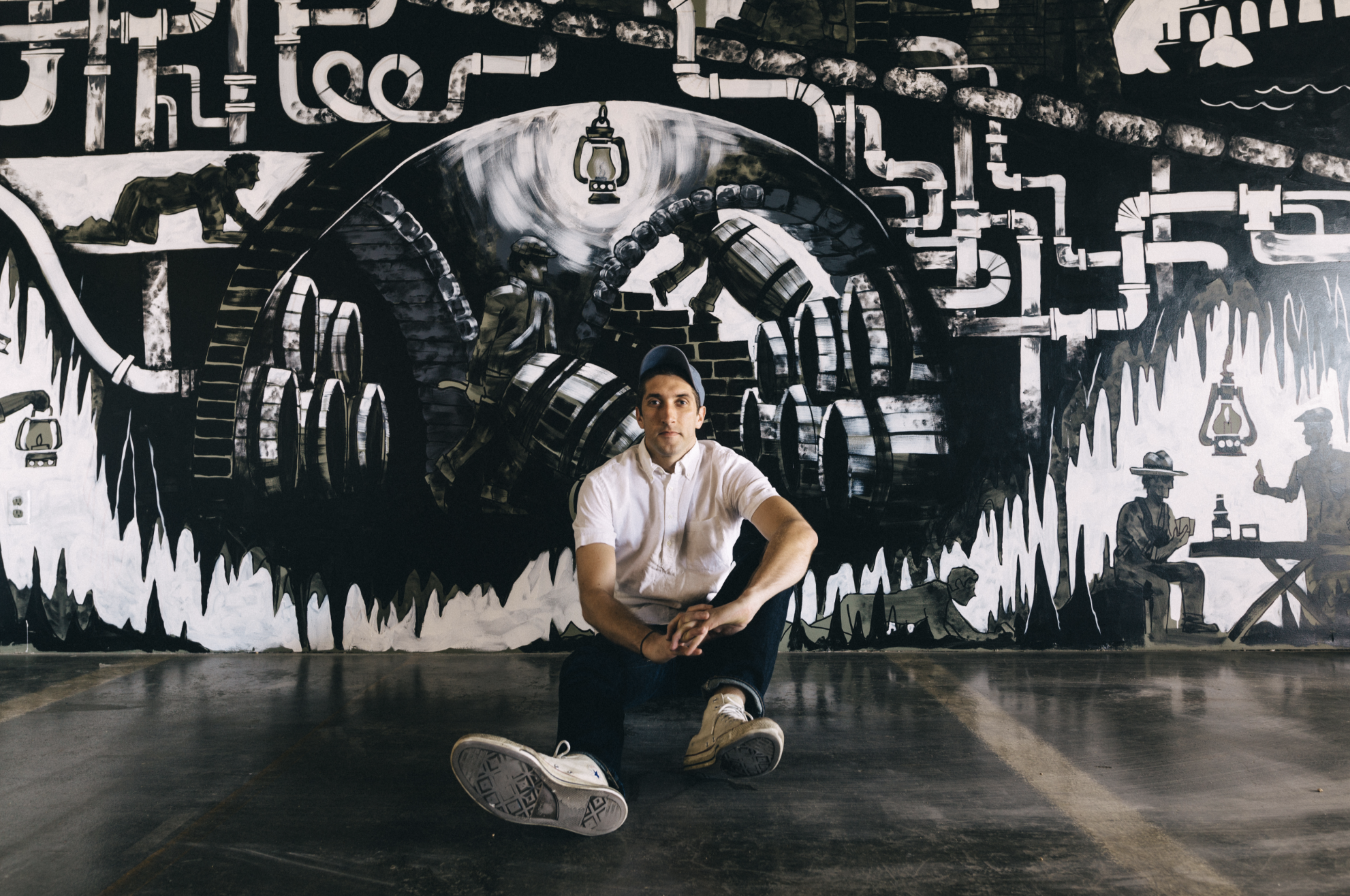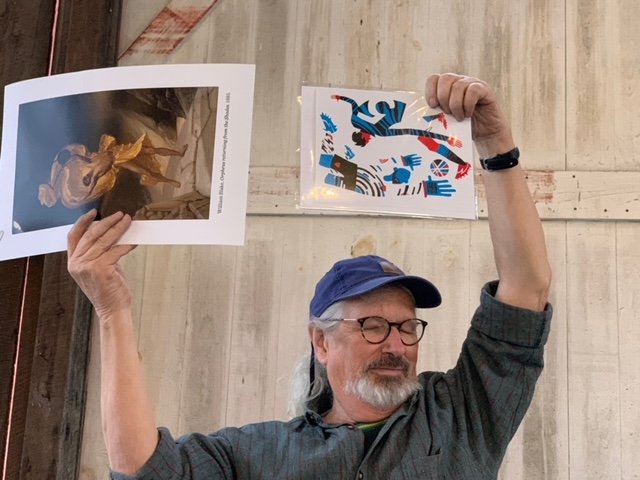Remembering Noah MacMillan
The late Noah MacMillan in front of his Underground City at the City Museum in St. Louis. 2016. Photograph by RJ Hartbeck. More photography of this project here.
I was lucky to know Noah MacMillan, a former student and friend whose far too brief life came to end on July 31, 2022. A Takoma Park, Maryland native, Noah attended Washington University in St. Louis and graduated from the Sam Fox School of Design & Visual Arts with a BFA in Communication Design (concentrating in illustration) in 2011. Noah spent his post-college years in St. Louis, leaving for Los Angeles with his fiancée Hitomi Inoue four or so years back. Noah began work on an MFA at the School of Visual Arts in New York City in 2019 but was unable to complete his degree for health reasons.
Hitomi and the MacMillan family arranged for two celebrations of Noah’s life: the first, in St. Louis, took place on Sunday, October 2, at the Sons of Rest pavilion in Tower Grove Park, a beloved spot. A second memorial event was held in Maryland on October 23.
I had corresponded with Noah’s father Jeffrey about the St. Louis event, and prepared remarks. Many lovely tributes poured forth from family and friends as the shadows lengthened across the grass, and I decided that nobody really needed to hear from me under the circumstances. I sought out Jeffrey as I left and said I would send him my thoughts. When I did so several days later, he thanked me and asked if I would permit the tribute I hadn’t delivered to spoken by someone else, during a second memorial planned for Maryland, the weekend before last. Of course I instantly assented. I have come to understand from his parents Lucinda and Jeffrey that Noah’s favorite high school history teacher Chris Jones read my words, and did so beautifully. (Thank you, Chris!)
Below, said remarks. The only thing I would add is the wonderful news that one of Noah’s soccer illustrations appears in a new round of United States Postal Service stamp designs announced in October. An airborne athlete in a similar illustration echoes Blake’s Orpheus-as-Goalie image in my talk, highlighted by Jeffrey MacMillan in a photograph from the October 23 event.
It’s an honor to be here with Noah’s family and his many intimate friends. It’s clear that he had a gift for friendship. As for me, I’m speaking in part as a representative of the Design faculty at the Sam Fox School at Washington University. Noah came through our program and embodied everything that we have ever hoped for our students: he was committed, collaborative, tenacious, generous, driven, accomplished.
Noah entered Communication Design in the fall of 2009. I worked with him in several courses, including a word and image studio and an academic seminar in visual culture. My best opportunity for sustained studio work with Noah came during his next-to-last semester, in the fall of 2010. I then taught a methods course for senior illustrators devoted to digging into students’ natural proclivities and cultural interests, to help each define a direction for their final semester. That process tends to result in fairly full-contact teaching. Noah was all the way in, and sought to make the most of it. His work was searching, hungry. He pushed himself extremely hard but did so good-naturedly. He was a supportive colleague to others, but not blandly so—he was acute in critique. The work he did the following semester with John Hendrix (who is unavoidably absent today but with us in spirit) was later featured in Smithsonian Magazine, and was juried into American Illustration 31. That spring Noah won our department’s Robert Weaver Prize in Visual Journalism, named for an illustrator he admired deeply, and whose values he shared. Weaver was the godfather of the graduate program at SVA that Noah selected to enter in the fall of 2019.
After he graduated Noah’s skill, personable nature, and leadership capacities led us to hire him to assist in teaching a digital design class in our burgeoning program. He did a splendid job so far as he got, until his illness waylaid him. He spent the next several years facing down that challenge, working on freelance illustration jobs between courses of treatment. I had always liked and appreciated Noah, but now I came to admire him deeply.
In the years after his recovery Noah worked courageously to rebuild a halting practice into a diverse, thriving enterprise, from mural work to editorial illustration to integrated efforts in design. His work was nationally recognized in our field, published in the major annuals. Noah’s reach came to extend beyond his immediate colleagues to the broader illustration community. He had a gift for leadership and the strength to step out ahead, but he could also come alongside to be a comrade and companion.
Five years ago I had the privilege of working with Noah on a very tight turnaround project—an animated sequence for projection at a major conference. My wife Lori has a video marketing and film business [Storytrack.com], and had hired Noah very early on to produce a suite of illustrations. The project in question was for Lori’s client, and would require a great deal of work on a very tight turnaround. To pull it off, I would need a collaborator, not an assistant, and we both thought, “Noah!” Luckily he was free. He and I spent a very intense 3 to 4 days producing the project, and had a blast together. I have treasured that memory ever since. Lori would be here were she not out of the country at the moment; she was very fond of Noah. But honestly, who wasn’t?
When I read Hitomi’s Twitter post announcing Noah’s passing only moments after it went up, I practically buckled over. I’d been on research leave and off in my own world, unaware. I still can’t quite wrap my head around it, any more than I can accept the sudden loss of my younger brother at the very beginning of this year. These leave-takings can be a rough business.
In 1885 the poet, artist, and printer William Blake painted Orpheus returning from the Shades. Orpheus was a unique character in the Greek array, a bard and musician who charmed the very stones beneath his feet. Such appeal enabled him to travel freely between the realm of the living and the underworld. Blake’s painting depicts Orpheus as an exultant figure proceeding along a stone incline curving through rock walls. At the end of an upraised arm, the bard’s left hand grasps the neck of a rounded lute, mirrored by a similar move with his right. A golden cloth wrapped around his waist billows impossibly behind him like a giant conch shell. Head back, eyes upward, Orpheus looks ready to launch himself to the plane of the living, a fusion of the athletic and the beautiful.
If you rotate the figure by 90 degrees, Orpheus looks like an outstretched goalie blocking the ball-shaped lute.
Recently I’ve been thinking about Noah and the story of Orpheus, about how his art and spirit continue to return to us. And I believe will keep doing so through the years.
The contemporary poet Michael R. Burch composed a take on that billowing musician-goalie, titled Orpheus, after Willam Blake.
It begins:
Many a sun
and many a moon
I walked the earth
and whistled a tune.
I did not whistle
as I worked:
the whistle was my work.
I shirked
nothing I saw
and made a rhyme
to children at play
and hard time.
To me that line, “children at play / and hard time,” packs a wallop. The fact is: Noah did not get as many suns or moons as we or he wanted.
But friends, even so and in every sense, we still have his whistle, which was his work.
Thank you.
I was determined to post this tribute before the last sands of 2022 run out. One of two such subjects weighing upon me…
Noah MacMillan, St. George and the Covid Dragon, 2020. Noah wrote of this image, “A tribute to the healthcare workers that put themselves in harm's way to keep us safe.”
Noah MacMillan, Airbnb Disaster, 2019. In Diablo Magazine. “For an article about a small town's reaction to a horrific shooting that took place during an out of control party at an Airbnb home.” I chose this piece because it shows an atmospheric side of Noah’s work that complements his frequent use of strong edges and contrasts.
Noah MacMillan, illustration for U.S. Women’s National Soccer Team stamp design for the United States Postal Service, designed by Antonio Alcalá. 2022. An October 25 article in USA Today reported that “[the] stamp issuance celebrates women’s soccer in the United States,” the USPS said. “…Millions of girls and women throughout the country participate in this fast-paced, competitive sport. The graphic stamp artwork depicts a female soccer player in action, walloping a ball with a side volley.” Walloping is a verb that Noah would have appreciated.
D.B. Dowd and Noah MacMillan with StoryTrack. Animation still. Lehigh Valley Logistics Center Case Study Teaser, Rockefeller Group, screened at NAIOP conference, 2017.
D.B. Dowd and Noah MacMillan with StoryTrack. Animation still. Lehigh Valley Logistics Center Case Study Teaser, 2017.
D.B. Dowd and Noah MacMillan with StoryTrack. Animation still. Lehigh Valley Logistics Center Case Study Teaser, 2017.
William Blake, Orpheus returning from the Shades. 1885.
Jeffrey MacMillan, Noah’s father, holding up a rotated print of Blake’s Orpheus next to one of Noah’s soccer illustrations of a diving goalie. The photograph was shot during Noah’s memorial on October 23 in Takoma Park, Maryland.









